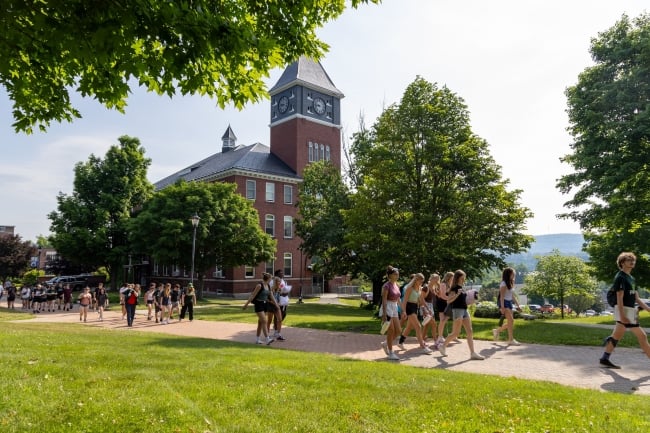You have /5 articles left.
Sign up for a free account or log in.

A new law requires New Hampshire institutions—including Plymouth State University—to explore more robust collaboration on enrollment and recruitment.
University System of New Hampshire.
This spring, after weathering years of plunging enrollments and tuition revenue, New Hampshire lawmakers gave the state’s public colleges and universities an order: work together, or sink together.
A state law passed in May requires the two systems to collaborate on easing credit transfer pathways, aligning enrollment initiatives and sharing recruitment resources, among other reforms. The systems will be required to follow recommendations for alignment put forward by a state task force in March.
It’s the Legislature’s latest effort to reverse steadily declining enrollment trends. Enrollment at the University System of New Hampshire, which includes the state’s three public four-year colleges, fell by 13.6 percent between 2019 and 2023, according to an annual financial report from 2023. At the Community College System of New Hampshire, enrollment dropped by 14.3 percent from 2018 to 2024, according to system data.
“Shifts in demographics and the needs of students, as well as the expectations of employers for a skilled workforce, require our institutions to take bold and immediate steps to work more effectively together,” the task force concluded. “The task force would be remiss if it did not establish a sense of urgency.”
New Hampshire colleges also face stiff competition for a shrinking pool of students. New England is one of the densest higher education ecosystems in the country, with a cluster of public and private colleges in neighboring states that are just a short drive for many Granite State residents. The state has consistently had the highest relative student export rate in the country: as of 2019, 61 percent of college-bound high school graduates went out of state for college, according to data from USNH.
The task force also recommended that the two systems consolidate some of their administrative offices and academic offerings, though its members recognized that may take “patience and discipline.”
“Significant alignments tend to emerge organically following a natural progression of cooperative and collaborative successes,” the report reads.
Stephen Appleby, director of the New Hampshire Department of Education’s Division of Educator Support and Higher Education, was one of the task force’s two co-chairs. He said it’s always a challenge to get community colleges and four-year institutions on the same page, or to combine administrative and student support functions—similar alignment initiatives in other states, he said, have been “like giving a root canal"—but in New Hampshire, he said, the appetite for improvement overpowers any internecine tensions.
“We’re a small state, and there’s a strong sense that we’re all in this together,” he said. “If student success hinges on us all playing nicely, that’s what will happen.”
The alignment work is already underway, especially in streamlining credit transfer. In June the three USNH campuses—the flagship University of New Hampshire, Plymouth State University and Keene State College—joined a transfer guarantee program, promising to admit all transfer applicants from New Hampshire community colleges who meet a minimum GPA requirement. The deal also waives application fees and essay requirements for transfers and makes them eligible for scholarship and grant opportunities previously available only to incoming first-years. Some of the task force’s recommendations are more radical, like piloting three-year bachelor’s degree programs, expanding short-term certificate programs, exploring direct admissions and consolidating the application and financial aid process for campuses in both systems under a common platform.
The USNH is even moving its headquarters from an office complex in Concord to the campus of the New Hampshire Technical Institute, the state’s largest community college, aligning it with the task force’s recommendation to boost administrative efficiency and coordinate planning and outreach with CCSNH.
USNH chancellor Cathy Provencher said the move is also a symbolic commitment to stronger intersystem collaboration.
“Almost every recommendation in the [task force’s] report is already underway,” she said. “There are challenges, but both systems are committed to working better together.”
Different Strokes, Same Boat
New Hampshire’s demographic problem is dire. Its population is one of the oldest in the country, with 20 percent of Granite Staters over the age of 65. The number of public high school graduates has fallen by 25 percent over the past two decades and is projected to drop by 1.5 percent every year for the next decade, according to the task force’s report.
Kim DeRego, vice provost for enrollment management at the University of New Hampshire, said colleges can’t keep relying on traditional 18-year-old applicants to fill incoming classes.
“When you look ahead to the next decade, the next 20 years, there’s really not enough babies born in New England to keep the higher education rate the way we’ve had it,” she said.
Community colleges are already dealing with that reality: nearly two-thirds of CCSNH students are over the age of 23, according to system data. Appleby said that by coordinating recruitment efforts for adult learners and easing re-entry for the large pool of students with uncompleted degrees, both USNH and CCSNH campuses can expand their market demographic substantially.
DeRego and Provencher said they anticipate that four-year campuses’ proportion of nontraditional students will increase as the number of traditional first-year students decreases. But they were careful to note that the culture and missions of the two systems are different, and will remain so, and that they’re also targeting other prospective student populations, like international and out-of-state students, to fill emptying seats.
Appleby said there are other ways New Hampshire’s four-year institutions can learn from their two-year cousins. Community colleges have invested heavily in expanding online education since the pandemic, for instance, and while they face a serious threat from the private online education behemoth Southern New Hampshire University, he said those programs have attracted new students who want more flexibility.
One of the major recommendations from the task force was to ease credit transfer pathways from New Hampshire community colleges to USNH institutions, a goal on which Provencher said the systems have made “very significant” progress. In 2022, the state Legislature passed a law mandating USNH and CCSNH coordinate to ease credit transfer between two- and four-years, which resulted in them developing 50 unique transfer pathways for community college students; DeRego said by the end of this year the system will have over 100.
“It’s been incredibly helpful to have this mandate,” she said. “It’s really helped streamline and organize efforts we’d been pursuing in a less organized fashion for years.”
Appleby said part of the challenge in facilitating a more collaborative approach to statewide postsecondary enrollment is helping both community colleges and four-year universities expand their idea of a typical prospective student and their expectations for academic success.
“It’s more challenging on the four-year side than the two-year side,” Appleby admitted, an issue he chalked up to fears of diluting academic rigor and shared governance among faculty. “Both systems have different cultures, and both do different things great … It presents an enormous opportunity for them to learn from each other.”
Last-Ditch Effort?
In 2021 Governor Chris Sununu proposed merging USNH and CCSNH, provoking backlash from administrators, faculty and legislators. His administration eventually backed away from the plan, but the effort sent a clear message that something had to change.
The threat of returning to 2021’s unpopular merger proposal has not been made explicit, but it’s humming behind every new batch of distressing enrollment data, every disappointingly small class. Recent consolidations, campus closures and sweeping program cuts at public systems in other states with similar demographic pictures—like Pennsylvania, West Virginia and Wisconsin—have been a wake-up call for the state. New Hampshire has tested the merger waters since then, too: last year Granite State College, a public institution focused on serving adult learners, merged with UNH to become the university’s College of Professional Studies.
“I’m sure the possibility of mergers and cuts are in the back of everyone’s mind,” Appleby said. “We don’t live in a vacuum.”
Provencher said she doesn’t see the collaborative mandate as a last-ditch push to prove New Hampshire institutions can boost enrollment. But she does anticipate the state’s public systems and campuses will continue working together to solve its existential crises.
“In higher ed these days, there are no final tests … this is iterative work,” she said. “We need to be constantly changing and open to questioning past practices … These enrollment challenges will likely continue, and we’ll continue to address them.”





